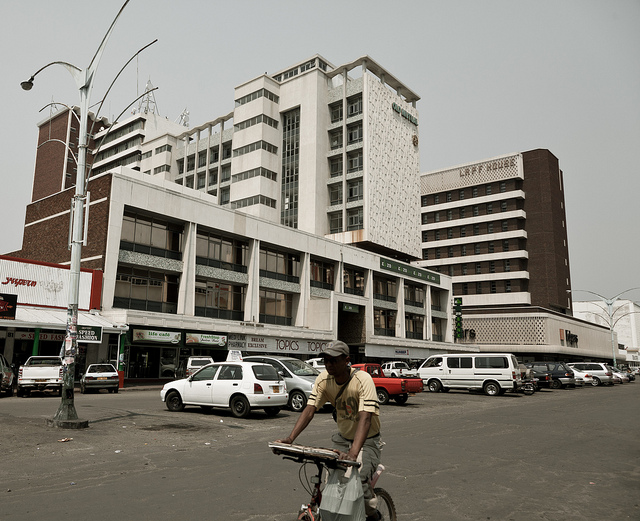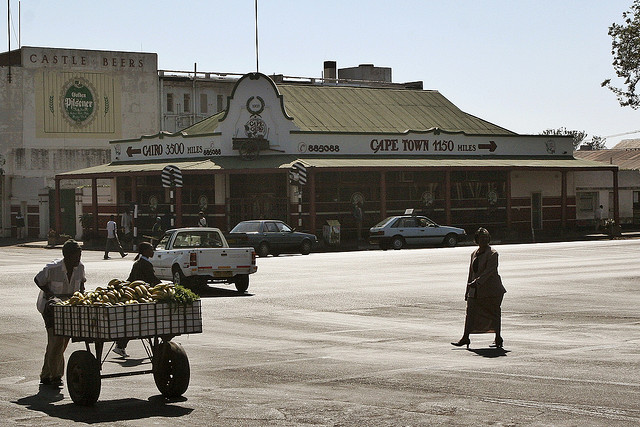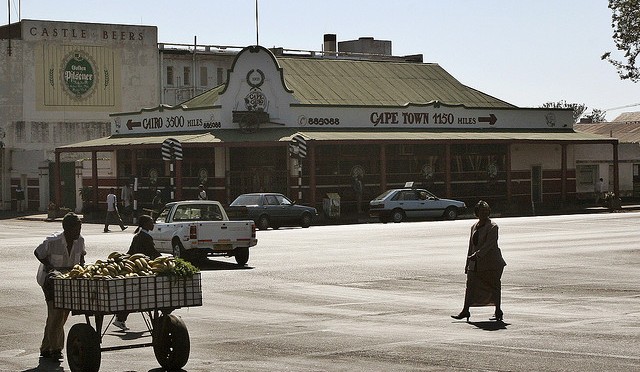Our train from Victoria Falls arrived in Bulawayo around mid-morning. After quickly locating a taxi to take us Burke’s Paradise, an inexpensive backpacker place on the outskirts of town, we decided to take it easy that morning and rest after our overnight travels.
Unfortunately, we could not lounge around for too long because Burke’s is a self-catering operation. Thanks to an email from the owner, we knew about this prior to arrival, but we had lacked the energy to stop at the Food Lover’s Market (the Southern African answer to Whole Foods) that we had spotted during our morning taxi ride from the train station to Burke’s. So, after a quick nap, we trekked back to town in one of the shared minibus taxis that ply Bulawayo’s main roads. We ate lunch in the Food Lover’s Market’s enclosed cafe and picked up some supplies to make dinner.
We returned to Burke’s to find that the power had gone out. At first, we were not concerned. Rolling blackouts had been a somewhat common occurrence during our travels across Southern Africa. Unlike those previous circumstances, this power outage persisted for several hours. We watched the sun set, and then sat in the dark, wondering how we would cook dinner – candlelight dining is lovely, candlelight cooking is less fun. Thankfully, the power came back just before we wandered into the shared kitchen to begin chopping up our vegetables.
We soon discovered, however, that the early evening’s lack of electricity would be the lesser of our concerns that night. Although the entirety of Zimbabwe lies above the Tropic of Capricorn, the southwestern portion of the country – where Bulawayo is located – is dominated by a high plateau that can get very cold during the evening. As soon as the sun set on our first day in Bulawayo, the temperature began to plummet, nearly reaching freezing that night.1 We went to bed cold and woke up in the morning shivering, steeling ourselves for the rest of the day, with the temperature not forecasted to exceed 60°F.2
Our aim in having come to Bulawayo was to visit Matobo National Park, an UNESCO world heritage site containing hundreds of San rock paintings3 and the gravesite of Cecil Rhodes, located just 35 kilometers outside of Bulawayo. Upon arrival in Bulawayo, however, we discovered the complete lack of any affordable way to visit the area on our own. The only real option we found to visit the area was a guided, full-day tour of the historic site and its adjoining game park, something that would have cost us $120 per person.4 We found this particularly frustrating because the only thing that we really wanted to do was visit the rock paintings – we had little interest in the game park, having just come off of a speculator visit to Chobe National Park less than a week prior. After spending the better part of a day soul-searching, we decided to give Matobo a miss. This was the first time on our trip that we had simply abandoned our plans, and it was not a decision that we made lightly.5
Feeling defeated, we sat around Burke’s and tried to keep warm. We knew we would need to return to town to restock our food supplies, and decided to try to salvage part of the day by first walking around downtown Bulawayo, which was supposed to have a couple of museums along with some good examples of art deco architecture.6 We wandered around the city center for a while, but found the surroundings to be rather unremarkable.7 Perhaps we were swayed by the cold, but Bulawayo just appeared to us like another typical medium-sized African city, with its downtown largely centered on drab government buildings, generic discount retailers, and uninviting-looking fried food outlets. Our guidebook indicated that there was a “lovely cafe” in the National Art Gallery, but we were unable to find any trace of it in the building. The map of the gallery showed a “tea room,” but there was no way to access that room in real life. Growing increasingly hungry, we once again sought refuge in the Food Lover’s Market on the way back to Burke’s.

Returning to Burke’s that evening, we moved out of our double room and into the four-person dorm. Although that sounds like a downgrade, it significantly improved our lot. The dorm was located in a much better constructed building (read: more insulated) than the annex containing our double room. Also, the dorm was empty, making it effectively just a giant private room with an en suite bathroom.8 Most importantly, we located a space heater in the dorm’s adjacent lounge area that we were able to plug in and huddle around before going to bed.
We had been traveling at a pretty quick pace for nearly a month by the time that we arrived in Bulawayo and had not spent more than two nights in the same location since leaving Cape Town. Although we desperately needed someplace where we could just simply kick back and relax for several days to regain our energy, Bulawayo was not that place for us. Even though our second night was a vast improvement on the first, we were both ready to get the hell out of town by the following morning.
In all fairness, the travelers’ fatigue/burnout from which we had already been suffering before our arrival in Bulawayo, combined with the unseasonable cold snap that happened to coincide with our travels, were specific to our visit and really should not be extrapolated.9 Nonetheless, for the first time on our trip, Katie and I both began to have doubts about our interest in continuing to travel. The major benefit to having purchased one-way tickets to Africa is our flexibility to return to the United States whenever, and from wherever, we eventually want. We quickly realized that one of the downsides to this approach, however, is that it only took a few bad travel days in row for us to contemplate throwing in the towel. Although we had aspirationally set out to travel through Southern and Eastern Africa, and perhaps all the way to up Northern Africa, during a couple of low points in Bulawayo, I began seriously searching around for potential flights to come home much sooner.

Where We Stayed:
☆ Burke’s Paradise. Three goats. We are just going to ignore the freezing weather and instead warn you not to travel in that corner of Zimbabwe on the eve of African winter. It was cold at Burke’s Paradise, but the building construction and lack of indoor heating is not uncommon for Southern Africa. The location is not ideal, since it is beyond walking distance from town and a taxi ride to/from downtown will set you back $10 each way (note: the shared minibus taxis are much cheaper, but are no good for when you need to transport your bags), but the grounds are pretty with lots of greenery. The owner and his wife, who live on the property with their children and a friendly little dog, are very helpful (although they could not do much for us on the Matobo front) and happy to chat with you about your travels. There is fast, cheap wifi and a selection of essentials (water, cooking oil, instant noodles, chocolate) for purchase as well in case you arrive after the grocery stores have closed.
1 In many parts of the world, such temperatures would be rather unremarkable, especially during late fall. But without indoor heating – something which is not common across Southern Africa, despite the fact that many areas can be rather cold during parts of the year – it was distinctly unpleasant.
2 Again, in many part of the world, such cool days are a regular occurrence. Unfortunately, being limited in the amount of stuff that we could cram into our backpacks, we lacked the appropriate clothing for this weather, with long sleeve shirts and light fleece jackets being our heaviest outerwear.
3 We had already seen San rock engravings in Namibia.
4 Despite what you might otherwise assume for a country with one of the lowest per capita GDPs in the world, travel in Zimbabwe is not cheap. As we quickly learned, the prices for many goods and services are rather high – a phenomenon that has its roots in the country’s recent period of hyperinflation and economic collapse. For a great discussion of the issue, check out this article by Michael Hobbes in the New Republic : “Zimbabwe Prices: Why Are They as High as New York City’s?”
5 Even when other sites had been closed, we still managed to finagle interesting experiences. See, e.g., penguins; more penguins.
6 We were not really in the mood to take pictures while Bulawayo and thus have little visual evidence of our time here. Therefore, this post is illustrated with images culled from the Flickr Creative Commons.
7 Although there are a handful of notable exceptions (e.g., Cape Town), Africa’s allure is generally lies in its scenic beauty and friendly people, not necessarily its urban landscapes.
8 This was the first time in weeks that we had not been forced to trudge outside to go to the bathroom.
9 Although I thought they were a bit odd, another couple staying at Burke’s was completely enamored of Bulawayo. They had already been in town for over a week by the time that we arrived and told us that they had found the city to be inescapably captivating. Perhaps I should have asked them to take us on a walking tour.


